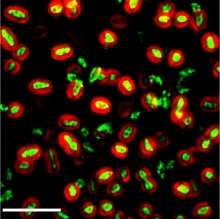Getting from greenhouse gas to microbial biomass

Greenhouse gases such as carbon dioxide (CO2) and methane (CH4) are emitted into our atmosphere as waste products of current energy production activities. But imagine turning this waste carbon into biomass - a reliable, economical, and safe source of feedstocks for biofuels and other bioproducts.
Microbial biomass is a clean, renewable energy source. It has the potential to significantly diversify and sustain future energy and transportation fuel requirements.
A new paper by researchers at the Pacific Northwest National Laboratory (PNNL) describes a process that captures methane from natural gas and biogas and that uses photosynthesis to convert it into biomass feedstock. In this way, energy-rich carbon is not dispersed into the atmosphere as a greenhouse gas. Instead, it is converted to useful products.
Microbial biomass is a promising intermediate feedstock for synthesizing biofuels and bioproducts. It can be processed by using modern thermochemical conversion technologies, including hydrothermal liquefaction and pyrolysis methods that produce biocrudes that are much like petroleum crude oils.
The new process is scalable and flexible, and presents a proof-of-concept that obtains exceptional biomass productivity compared to future targets for algal biomass production.
At the heart of the process is a new way to cultivate engineered microbial consortia that self-regulate members' growth. It does this by harnessing a natural metabolic coupling between two organisms: photosynthetic cyanobacteria and methane-oxidizing bacteria. The resulting scheme is more stable and reliable than conventional methods of producing energy-viable biomass via photosynthesis and methane oxidation alone.
This new benchmark technology for co-cultivation converts anthropogenic CH4 and CO2 into beneficial microbial feedstocks in a way that positively impacts the environment. Presently, these two gases are the largest manmade contributors of greenhouse gases to the atmosphere. That's because a large fraction of natural gas and biogas - significant sources of manmade CH4 and CO2 – are flared or vented into the air. Losses of the natural gas co-produced with oil recovery, for instance, are equivalent to wasting 5 quadrillion BTUs of energy a year.
The new paper, by lead author Eric Hill and three other PNNL researchers, proposes a way to accomplish that beneficial conversion: a robust, integrated, self-regulating co-cultivation platform of well-known microbes. One derives energy from the sun (a photoautotrophic cyanobacteria) and the other from the oxidation of methane (a methanotroph). This cyanobacteria-methanotroph binary culture is based on a robust and natural metabolic coupling between energy from the sun (oxygenic photosynthesis) and energy from methane oxidation.
The culture is amenable to metabolic engineering, which makes the platform flexible and scalable for the production of different bioproducts based on cost-effective, renewable CO2 and CH4 feedstocks.
Many state-of-the-art biotechnologies already in development are trying to capitalize on the productivity and stability derived from co-cultivating microbial consortia. But this PNNL study, directed by corresponding author Hans Bernstein, presents a new benchmark in co-culture technology – a scalable platform for engineering custom bioprocesses. It's safer, more flexible, and more stable than previously presented methods for generating microbial biomass or bioproducts from CO2 and CH4.
The ability of multi-species microbial consortia to capture and convert CH2 and CO2 represent a tremendous future research opportunity for biotechnologists and engineers.
More information: Eric A. Hill et al. A flexible microbial co-culture platform for simultaneous utilization of methane and carbon dioxide from gas feedstocks, Bioresource Technology (2017). DOI: 10.1016/j.biortech.2016.12.111
















